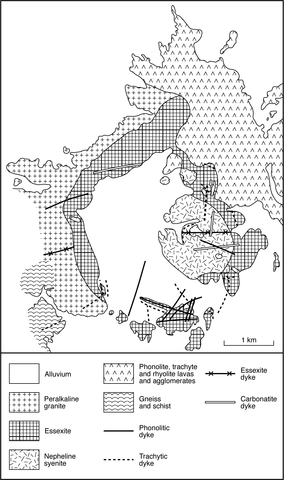stripes
Emplaced in Precambrian granite gneisses, amphibolites and schists, the complex comprises a central nepheline syenite stock, an inner ring of essexite, and a partial outer ring of peralkaline granite. The northeastern part of the intrusion is hidden beneath volcanic rocks representing the remains of a volcanic cone. The volcanics are 300-400 m thick and comprise trachytic and rhyolitic lavas and agglomerates with fragments of trachybasalt and phonolite. They are cut by nepheline syenites and essexites and a range of dykes. The central stock consists principally of foyaite containing alkali feldspar, approximately 20% nepheline, which may be replaced by analcime, cancrinite or zeolite, aegirine-augite, and a little biotite and opaque phases. Small stock-like bodies within the foyaites consist of 'ditroite' which is richer in nepheline and pyroxene than the foyaites and contains eudialyte, while veins of albite-nepheline-aegirine-augite rock, again with eudialyte, are referred to as litchfieldites (El Ramly et al., 1969b). The so-called essexites of the inner ring are cut by both the nepheline syenite stock and the granites of the outer ring. They are coarse to very coarse, with about 60% oligoclase-andesine, 25% orthoclase, some altered nepheline, a little titanaugite, sodic amphibole and accessories. The granites of the outer ring are generally peralkaline with albite-oligoclase, biotite and a little sodic amphibole. A broad range of dykes occurs corresponding to the three rock suites of the main complex. A few dykes of carbonatite have also been recognised (El Ramly et al., 1969b). Modes and whole rock analyses are given by El Ramly et al. (1969b) and trace element data by Hussein and Hassan (1973) and Soliman (1987).
EL RAMLY, M.F., BUDANOV, V.I., ARMANIOUS, L.K. and DERENIUK, N.E. 1969b. The three ring complexes of Gabal El Kahfa, Gabal Nigrub El Fogani and Gabal El Naga (South Eastern Desert of Egypt). Geological Survey of Egypt, Paper, 52: 1-39.HUSSEIN, A.A. and HASSAN, M.A. 1973. Further contribution to geology and geochemistry of some Egyptian ring complexes. Annals of the Geological Survey of Egypt, 3: 167-75.OMAR, G.I., KOHN, B.P., LUTZ, T.M. and FAUL, H. 1987. The cooling history of Silurian to Cretaceous alkaline ring complexes, South Eastern Desert, Egypt, as revealed by fission-track analysis. Earth and Planetary Science Letters, 83: 94-108.SERENCSITS, C.M., FAUL, H., FOLAND, K.A., EL RAMLY, M.F. and HUSSEIN, A.A. 1979. Alkaline ring complexes in Egypt: their ages and relationship to tectonic development of the Red Sea. Annals of the Geological Survey of Egypt, 9: 102-16.SOLIMAN, M.M. 1987. The younger granites and ring complexes of the Southeastern desert of Egypt and their relation to mineralization. Journal of African Earth Sciences, 6: 745-54.

